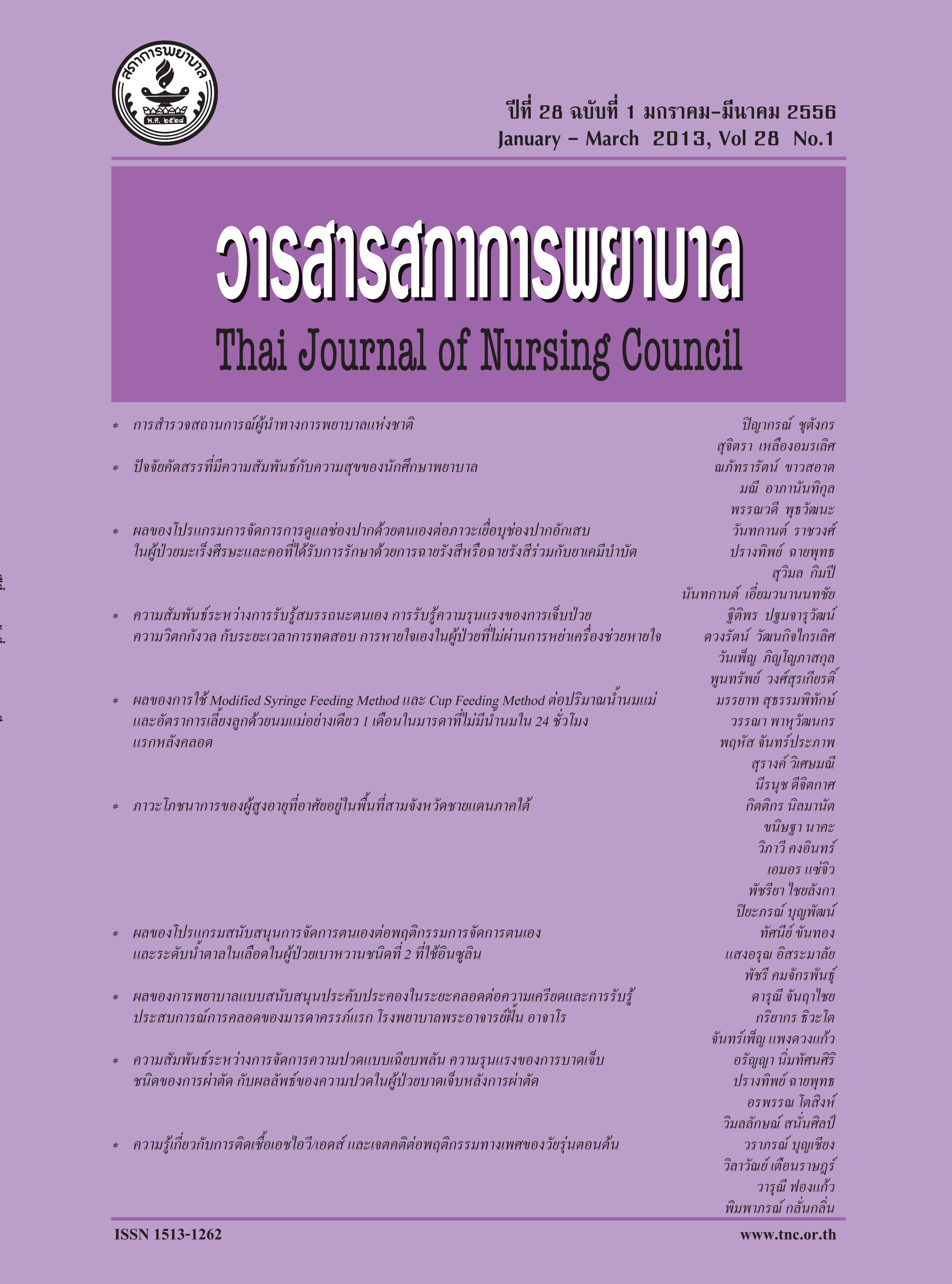ผลของการใช้ Modified Syringe Feeding Method และ Cup Feeding Method
Abstract
บทคัดย่อ
วัตถุประสงค์ของการวิจัย: เพื่อเปรียบเทียบผลของการใช้ Modified Syringe Feeding Method (MSFM) และ Cup Feeding Method (CUP) ต่อปริมาณนํ้านมแม่และอัตราการเลี้ยงลูกด้วยนมแม่อย่างเดียว 1 เดือนในมารดาที่ไม่มีนํ้านมใน 24 ชั่วโมงแรกหลังคลอด
วิธีดำเนินการวิจัย: กลุ่มตัวอย่างเป็นมารดาหลังคลอดปกติที่ไม่มีนํ้านมใน 24 ชั่วโมงแรก ไม่มีภาวะแทรกซ้อน ย้ายมาหน่วยหลังคลอดพร้อมลูกไม่มีปัญหาหัวนม ทารกไม่มีพังผืดใต้ลิ้น จำนวน 50 รายแบ่งเป็น 2 กลุ่มๆ ละ 25 ราย กลุ่มที่ 1 ได้รับการช่วยเหลือวิธี MSFM ส่วนกลุ่มที่ 2 ได้รับการช่วยเหลือวิธี CUP หลังจากช่วยเหลือจนครบ 24 และ 48 ชั่วโมง วัดปริมาณนมแม่ก่อนให้นมมื้อต่อไป โดยการปั้มนมด้วยเครื่องปั้มนม และตวงนํ้านมแม่ และติดตามการเลี้ยงลูกด้วยนมแม่อย่างเดียวภายหลังออกจากโรงพยาบาล 1 เดือน การวิเคราะห์ ข้อมูล ใช้สถิติร้อยละ ค่าเฉลี่ย ส่วนเบี่ยงเบนมาตรฐาน สถิติไคแสควร์ (Chi-square) และ ทีอิสระ (Independent t-test)
ผลการวิจัย: ปริมาณนํ้านมแม่หลังได้รับการช่วยเหลือด้วยวิธี MSFM จนครบ 24 ชั่วโมง มากกว่าปริมาณนํ้านมภายหลังการช่วยเหลือด้วยวิธี CUP อย่างมีนัยสำคัญทางสถิติ (p = .02) แต่เมื่อครบ 48 ชั่วโมง ปริมาณนํ้านมแม่ ภายหลังการช่วยเหลือทั้งสองวิธี ไม่แตกต่างกัน อย่างมีนัยสำคัญทางสถิติ (p = 0.73) และอัตราการเลี้ยงลูกด้วยนมแม่อย่างเดียว 1 เดือน ของทั้งสองกลุ่มเท่ากัน
ข้อเสนอแนะ: การช่วยเหลือมารดาหลังคลอดระยะแรกที่ยังไม่มีนํ้านมโดยการใช้ MSFM
เป็นทางเลือกหนึ่งในการเพิ่มปริมาณนํ้านมนอกเหนือจากการป้อนด้วยแก้ว
วารสารสภาการพยาบาล 2556; 28(1) 64-74
คำสำคัญ: การเลี้ยงลูกด้วยนมแม่ มารดาหลังคลอด การป้อนนมด้วยแก้ว ปริมาณนํ้านมแม่
Abstract
Effects of Modified Syringe Feeding Method and Cup Feeding Method on
Lactation and Breastfeeding during the First Month after Birth living:The Case of Post-Childbirth Mothers without Breast Milk in the 24 Hours After Birth Giving
Munyat Soothampitag
Wanna Phahuwatanakorn
Pharuhas Chanprapaph
SurangVisesmanee
Neeranuch Deejitgard
Abstract: Objective: To compare the effects of Modified Syringe Feeding Method (MSFM) and Cup Feeding Method (CUP) on mothers without breast milk during 24 hours after birth, in the light of their lactation and breastfeeding during the first month after birth.
Research Procedure: The sample consisted of 50 mothers who had just given birth but produced no breast milk during the first 24 hours after birth giving. The subjects, none of whom was showing any birth-giving complications or mammilla problems, had been transferred to the post-natal ward with their babies, none of whom had sublingual fascia. The 50 subjects were then divided equally into two groups; to one group MSFM was administered, and to the other CUP was administered. After 24 and 48 hours of treatment, respectively, each mother’s amount of breast milk was measured before breast milk was collected by a breast-pump for the next round of breastfeeding. During the period of one month after discharge, each mother was monitored only in terms of her breastfeeding. The data obtained were analysed in terms of percentage, mean, standard deviation, Chi-square and Independent T-test.
Research Findings: After 24 hours of MSFM administration, the amount of breast milk
secreted was significantly higher than the amount obtained after the administration of CUP (p = .02). However, after 48 hours, the difference between the two methods was not statistically
significant (p = 0.73), and equal amounts of breastfeeding were observed in both groups of mothers during the one month after discharge.
Recommendations: To assist mothers with no breast milk after childbirth, MSFM could be an alternative for increasing a baby’s consumption of milk, in addition to milk-feeding using a glass.
Thai Journal of Nursing Council 2013; 28(1) 64-74
Keywords: breastfeeding; post-childbirth mothers; milk-feeding using a glass; amount of breast milk







